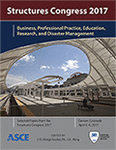Quantifying Structural Impact Demands Due to Tsunami-Generated Debris
Publication: Structures Congress 2017
Abstract
On-shore flow during tsunami events can transport a significant amount of debris as was evident from recent events such as the Japan 2011, Chile 2010, and Indonesia 2004. Tsunami-generated debris can place extreme loads on the structures they impact, particularly in the case of large debris items such as shipping containers and shipping vessels, where impact can result in the collapse of a system if not properly designed. The 2016 publication of the ASCE 7 Standard, Minimum Design Loads for Buildings and Other Structures, includes a new chapter entitled Tsunami Loads and Effects, which provides design engineers with guidance to protect tsunami prone regions of the U.S. against the forces that can be generated during tsunami events. The new tsunami loads chapter requires debris impact to be considered in the design of structures located in the tsunami inundation zone. The goal of this paper is to familiarize design engineers with the procedures required to calculate the impact demands on structures in tsunami prone regions. A case study of a tsunami prone region of the U.S. is used to demonstrate the impact demands that can be generated at a building site from common debris types such as: wood poles, empty and fully loaded shipping containers and passenger vehicles. As part of this case study three different methods are used to estimate the flow velocity and flow depths needed to determine the impact force and location at which the force is applied to a structural component. The modified energy method is recommended for flow characteristic approximations. For calculating impact force in the inundation region the standard provides two approaches that design engineers can utilize: (1) a conservative, prescriptive load specification, and (2) impact force and duration equations that utilize the approximated velocities. It was determined the main advantage in using the impact force and duration equations comes from the fact that a dynamic response factor can be determined based on the debris type and impacted structural component, which can potentially reduce the calculated debris impact static load. It is recommended that when applying the impact force to the structural component, further load cases should be explored for the impact force and duration equation as this can further improve the accuracy of the impact demands potentially allowing for more economical sections to be utilized.
Get full access to this article
View all available purchase options and get full access to this chapter.
Information & Authors
Information
Published In
Copyright
© 2017 American Society of Civil Engineers.
History
Published online: Apr 4, 2017
Authors
Metrics & Citations
Metrics
Citations
Download citation
If you have the appropriate software installed, you can download article citation data to the citation manager of your choice. Simply select your manager software from the list below and click Download.
